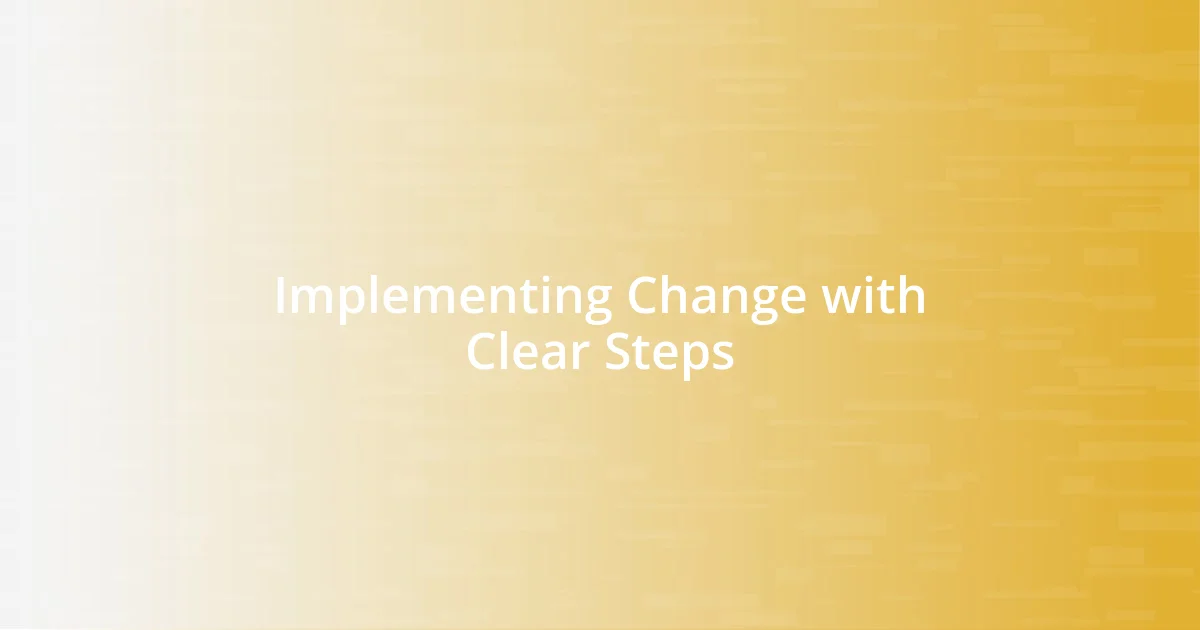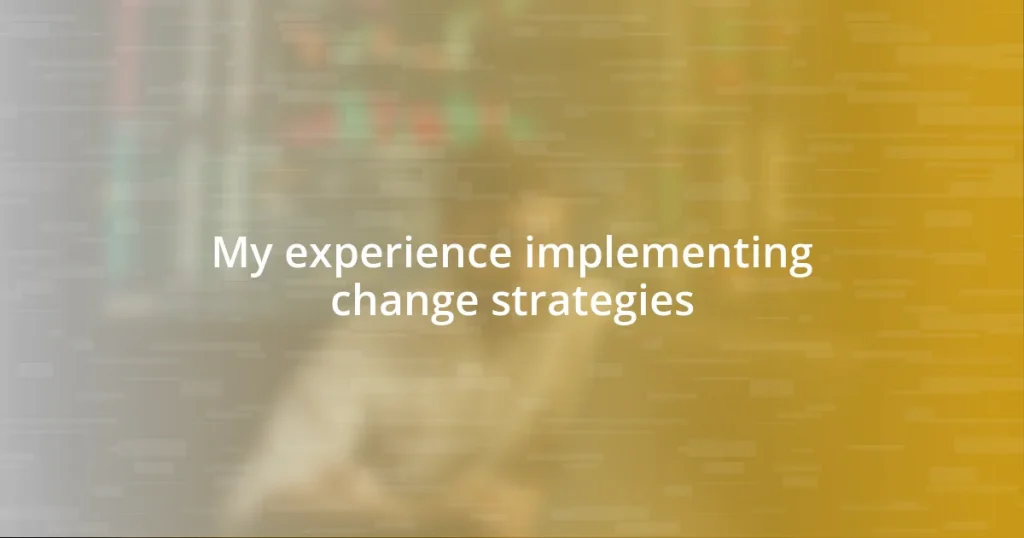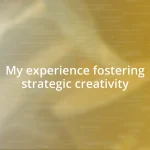Key takeaways:
- Emphasizing the emotional impact of change is crucial for addressing resistance and fostering buy-in.
- Engaging stakeholders early in the change process enhances collaboration, ownership, and trust, leading to more effective strategies.
- Measuring the impact of change should combine quantitative data with qualitative insights to capture the full experience of the team and ensure continuous improvement.

Understanding Change Management Principles
Change management principles are often seen as the backbone of any successful transformation effort. From my experience, recognizing the emotional impact of change is crucial. When I first led a change initiative, I noticed resistance not just to the changes themselves but to the uncertainty they brought. Have you ever felt anxious about something unknown? It’s a common reaction, and understanding this emotional aspect can make a world of difference.
One of the key principles I’ve come to value is the importance of communication. I remember a project where I almost overlooked this aspect, thinking, “Surely, everyone will understand the vision.” However, that led to misunderstandings and a lack of buy-in. Clear, ongoing dialogue helps bridge that gap, allowing team members to voice their concerns and feel more secure about the changes ahead. What if we could foster an environment where feedback is not just welcomed but actively sought?
Another critical principle involves stakeholder involvement. In one memorable project, I engaged team members early on, which not only boosted morale but also uncovered valuable insights I hadn’t considered. By involving people from the start, you create a sense of ownership and accountability. Have you ever wondered how much more seamless a transition could be with everyone on board? It’s astounding what collaboration and shared vision can achieve.

Identifying the Need for Change
Identifying the need for change can often feel like navigating a maze. I recall a time in my career when our team faced declining performance metrics. It didn’t just hit the numbers; it struck a nerve. I sensed the frustration and fear began to bubble beneath the surface. This emotional temperature check was crucial, as it helped me realize that the need for change wasn’t just about the data—it was about understanding the human side of the equation.
Engagement with my team revealed insights that numbers alone couldn’t provide. One day during a brainstorming session, a colleague candidly shared her fears about job security in the face of automation. This moment was pivotal; it dawned on me that our call for change had to address these real emotional concerns, not just operational efficiency. By openly discussing the implications of change, we could collectively identify the real need for transformation, which was to build trust and alleviate fears.
As I reflect on these experiences, it’s clear that identifying the need for change goes beyond surface-level observations. It’s about deep listening and creating spaces where team members feel safe expressing their thoughts. I often ask myself, are we really paying attention to the signals around us? The true need for change often emerges from the collective wisdom of the team, if only we take the time to tap into it.
| Indicators of Need for Change | Emotional Insights |
|---|---|
| Declining performance metrics | Frustration and fear within the team |
| Team feedback during discussions | Concerns about job security and change |

Developing a Change Strategy Framework
Developing a change strategy framework is like laying the foundation for a house; it requires careful thought and planning. I recall drafting my first strategy framework and realizing how crucial it was to align goals with actionable steps. It was an eye-opening experience as I mapped out each phase, considering how we could ensure clarity and transparency throughout the process. I learned that a well-defined framework not only serves as a guide but also instills confidence in the team.
To create an effective change strategy framework, here are some elements I recommend including:
- Clear Objectives: Define what success looks like. Establishing specific, measurable goals is essential for tracking progress.
- Stakeholder Engagement: Identify key stakeholders early to foster a sense of ownership. Their input is invaluable in shaping the direction of the strategy.
- Communication Plan: Develop a robust approach for ongoing messaging. Regular updates can mitigate uncertainty and build trust.
- Training and Support: Prepare your team with the necessary skills and resources to adapt to changes. Offering support can alleviate anxiety.
- Feedback Mechanisms: Create avenues for team members to voice their thoughts and concerns. This promotes an open dialogue and continuous improvement.
Reflecting on my journey, I noticed that balancing flexibility within the framework is equally important. A rigid strategy can lead to frustration, especially when unexpected challenges arise. I remember one initiative where we had to pivot midway due to a change in market conditions. It was daunting at first, but having a flexible framework allowed us to adapt smoothly while keeping the team aligned. Ultimately, a change strategy framework should empower your team to navigate through uncertainty with confidence.

Engaging Stakeholders in the Process
I’ve always felt that engaging stakeholders is like opening the door to a collaborative workshop rather than conducting a lecture. In one of my projects, I invited key stakeholders not just to comment but to contribute actively to the change plan. It was amazing to see how their unique perspectives shaped our strategies. I often wonder: how many great ideas go unheard because we fail to invite others into the conversation?
Listening became my most powerful tool. During a feedback session, one stakeholder shared a concern that had been weighing on them for weeks. It wasn’t just about the process; they expressed a fear of losing touch with the team’s core values. That moment was a wake-up call for me—it highlighted that engaging stakeholders isn’t merely about their input but also about addressing their emotional stakes in the process. By creating an atmosphere where everyone felt valued, we were able to move forward with renewed vigor and shared commitment.
To foster genuine engagement, I learned to be transparent and approachable. In one instance, I initiated regular check-ins, allowing everyone to voice concerns and share insights openly. This process not only strengthened trust but also equipped us to navigate challenges together. Have you ever felt the difference when stakeholders believe their voices matter? It’s like igniting a spark that drives a collective passion for change.

Implementing Change with Clear Steps
Implementing change with clear steps can feel daunting, yet I’ve found it incredibly rewarding when done right. There was a time when I approached a significant overhaul in our workflow. I broke down the entire process into bite-sized steps and communicated these phases to the team. This clarity alleviated a lot of anxiety and confusion—who doesn’t feel overwhelmed when facing a massive change? By simply outlining what to expect, I witnessed an increase in buy-in and enthusiasm from my colleagues.
As I navigated this journey, one key insight I gained was the importance of visual aids. During a team meeting, I sketched out our timeline on a whiteboard, highlighting each phase along the way. Seeing the progression visually sparked questions and discussions that I hadn’t anticipated. It was enlightening to realize that by translating complex ideas into clear visuals, we could anchor the abstract concepts and make them more tangible. Who knew a few stick figures and arrows could lead to such meaningful dialogue?
Moreover, I learned that celebrating small milestones is crucial. After completing the initial phase, we took a moment to reflect and acknowledge our efforts. I found that this not only boosted morale but also reinforced the shared purpose. Isn’t it inspiring to pause and recognize progress, no matter how small? It reminded me that implementing change is not just about the end goal; it’s about building momentum together.

Measuring the Impact of Change
Measuring the impact of change is often where the rubber meets the road. I remember a project where we implemented a new customer feedback system, and we set specific metrics to track its success. In our weekly meetings, reviewing those numbers became a moment of truth—a chance to celebrate victories and identify areas needing adjustments. I often found myself asking: are the numbers reflecting the real experience of our team?
One of the best lessons I learned was to blend quantitative data with qualitative feedback. After seeing initial positive trends in feedback scores, I decided to conduct informal interviews with team members. Their stories revealed deeper insights that numbers alone couldn’t capture. It was thrilling to discover that the emotional journey of our employees and customers held as much weight as the statistics we were tracking. Have you realized that sometimes the most valuable insights come through conversation rather than a spreadsheet?
To add more depth to our assessments, I introduced post-implementation reflection sessions. These gatherings provided a platform for everyone to share their perspectives on what was working and what wasn’t. I always left these with a sense of renewal and possibility, realizing that measuring change isn’t just about tracking progress—it’s about creating space for continuous dialogue and improvement. Wouldn’t you agree that shared experiences are often the best indicators of lasting change?

Lessons Learned from Change Initiatives
Implementing change often leads to unexpected lessons. I vividly remember a time when we launched a new project management tool. Initially, I assumed everyone would embrace it without a hitch, only to discover some team members were hesitant. Reflecting on their concerns helped me realize the importance of empathy in change initiatives. When I took the time to listen and understand their struggles, it forged a stronger bond within the team and fostered greater collaboration. Isn’t it fascinating how simply acknowledging someone’s feelings can transform resistance into support?
Another crucial insight was the power of adaptability. Early in my experience with change, there were instances where plans didn’t unfold as expected. Rather than feeling disheartened, I learned to remain flexible and pivot when necessary. One particular project had to be restructured halfway through, which initially sent me into a tailspin. Yet, this shift allowed us to innovate and consider new solutions we hadn’t thought of before. In hindsight, I’ve come to appreciate that setbacks can sometimes lead to even greater breakthroughs.
Lastly, I discovered that trust is the backbone of any change initiative. I once implemented a policy requiring staff to submit weekly project updates, thinking it would enhance accountability. However, it ended up causing frustration, as it felt like micromanagement. After realizing this, I opened up a dialogue explaining my intentions and solicited their input on how to achieve better transparency. This candid conversation not only strengthened our relationship but also led to a more effective system that everyone felt comfortable using. Don’t you think trust is essential in creating a positive change environment?















